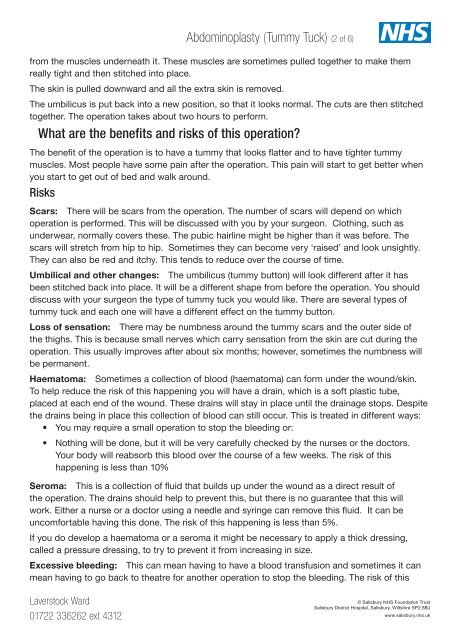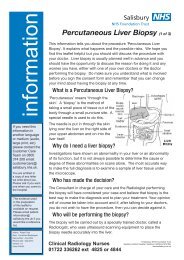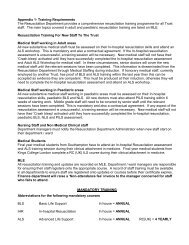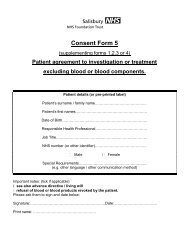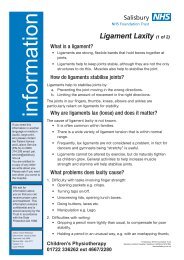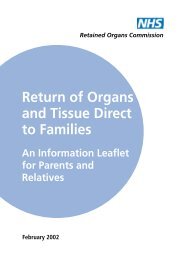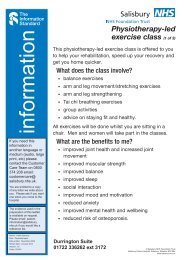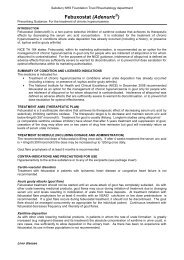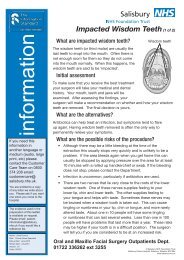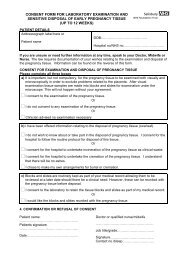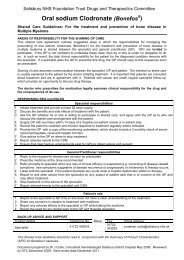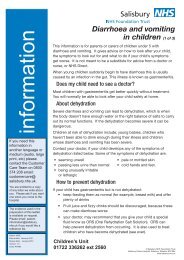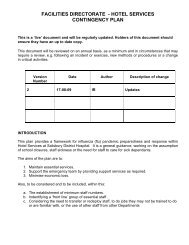Abdominoplasty (Tummy Tuck) - ICID - Salisbury NHS Foundation ...
Abdominoplasty (Tummy Tuck) - ICID - Salisbury NHS Foundation ...
Abdominoplasty (Tummy Tuck) - ICID - Salisbury NHS Foundation ...
You also want an ePaper? Increase the reach of your titles
YUMPU automatically turns print PDFs into web optimized ePapers that Google loves.
<strong>Abdominoplasty</strong> (<strong>Tummy</strong> <strong>Tuck</strong>) (2 of 6)<br />
from the muscles underneath it. These muscles are sometimes pulled together to make them<br />
really tight and then stitched into place.<br />
The skin is pulled downward and all the extra skin is removed.<br />
The umbilicus is put back into a new position, so that it looks normal. The cuts are then stitched<br />
together. The operation takes about two hours to perform.<br />
What are the benefits and risks of this operation?<br />
The benefit of the operation is to have a tummy that looks flatter and to have tighter tummy<br />
muscles. Most people have some pain after the operation. This pain will start to get better when<br />
you start to get out of bed and walk around.<br />
Risks<br />
Scars: There will be scars from the operation. The number of scars will depend on which<br />
operation is performed. This will be discussed with you by your surgeon. Clothing, such as<br />
underwear, normally covers these. The pubic hairline might be higher than it was before. The<br />
scars will stretch from hip to hip. Sometimes they can become very ‘raised’ and look unsightly.<br />
They can also be red and itchy. This tends to reduce over the course of time.<br />
Umbilical and other changes: The umbilicus (tummy button) will look different after it has<br />
been stitched back into place. It will be a different shape from before the operation. You should<br />
discuss with your surgeon the type of tummy tuck you would like. There are several types of<br />
tummy tuck and each one will have a different effect on the tummy button.<br />
Loss of sensation: There may be numbness around the tummy scars and the outer side of<br />
the thighs. This is because small nerves which carry sensation from the skin are cut during the<br />
operation. This usually improves after about six months; however, sometimes the numbness will<br />
be permanent.<br />
Haematoma: Sometimes a collection of blood (haematoma) can form under the wound/skin.<br />
To help reduce the risk of this happening you will have a drain, which is a soft plastic tube,<br />
placed at each end of the wound. These drains will stay in place until the drainage stops. Despite<br />
the drains being in place this collection of blood can still occur. This is treated in different ways:<br />
• You may require a small operation to stop the bleeding or:<br />
• Nothing will be done, but it will be very carefully checked by the nurses or the doctors.<br />
Your body will reabsorb this blood over the course of a few weeks. The risk of this<br />
happening is less than 10%<br />
Seroma: This is a collection of fluid that builds up under the wound as a direct result of<br />
the operation. The drains should help to prevent this, but there is no guarantee that this will<br />
work. Either a nurse or a doctor using a needle and syringe can remove this fluid. It can be<br />
uncomfortable having this done. The risk of this happening is less than 5%.<br />
If you do develop a haematoma or a seroma it might be necessary to apply a thick dressing,<br />
called a pressure dressing, to try to prevent it from increasing in size.<br />
Excessive bleeding: This can mean having to have a blood transfusion and sometimes it can<br />
mean having to go back to theatre for another operation to stop the bleeding. The risk of this<br />
Laverstock Ward<br />
01722 336262 ext 4312<br />
© <strong>Salisbury</strong> <strong>NHS</strong> <strong>Foundation</strong> Trust<br />
<strong>Salisbury</strong> District Hospital, <strong>Salisbury</strong>, Wiltshire SP2 8BJ<br />
www.salisbury.nhs.uk


